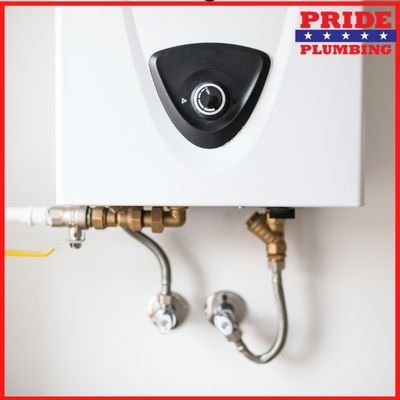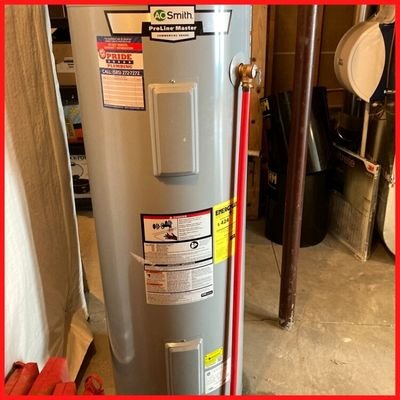Choosing the Best Water Heater for Your Home:
What is the Best Option for you?
What does taking a shower, running your dishwasher, and doing laundry all have in common? They’re some of the many daily tasks that require hot water. Your water heater is responsible for providing the hot water your faucets and appliances need. Choosing the wrong water heater or neglecting to maintain your water heater can lead to not having enough hot water, your water having an inconsistent temperature, and worsened quality of your water. Here at Pride Plumbing, we understand how important it is to choose the right water heater and learn proper maintenance for it. Read on to learn more about choosing a water heater and keeping it functioning properly.
Your Options with Pride Plumbing
When investing in a new water heater, you can choose between a traditional storage-tank water heater or a tankless water heater. A traditional storage-tank water heater uses its tank to heat and store water. As the name suggests, a tankless water heater does not have a storage tank. Water is heated and circulated through your water lines instead of inside a tank. We offer 40, 50, and 75-gallon tank water heaters in both tall and short. Short models of these tanks are slightly shorter and wider than the tall models. The shape and size of your tank are determined by how much hot water you need and the space you will be putting the water heater in. A more narrow, tall space will allow room for a tall model tank. If the area you plan on placing your water heater in is low and wide, it will be more likely to be able to accommodate a short tank model.
There are several things to keep in mind when choosing which water heater you’d like to have installed. The size and style of your home, the number of people in your household, the number of appliances and fixtures that will be using hot water in your home, and the power source you will be using to power your water heater. If you’re unsure what your specific hot water needs are, your technician will be able to assist you.
Natural gas or electricity is what powers traditional tank storage water heaters. Water flows into the storage tank at around 50 degrees Fahrenheit. Cool water is heated in a gas water heater by a flame held under the storage tank. As the water heats up at the bottom of the tank, it rises to the top pushing the cold water down to be warmed. Running on natural gas instead of electricity allows gas water heaters to continue working during a power outage. Gas water heaters also heat the water slightly quicker than electric water heaters. Electric water heaters work similarly to gas water heaters, the only difference being that those heating elements inside the tank heat the water. Because electric water heaters are powered by electricity, they will not continue to work during a power outage.
While almost every home has access to electricity, not all homes have access to natural gas. Homes without access to natural gas use an electric water heater. Pride Plumbing of Rochester carries AO Smith ProLine electric water heaters in 40 and 50-gallon sizes. Thick insulation inside electric water heaters reduce the cost of operating them. This insulation keeps heat inside of the water heater’s tank longer. Less heat loss leads to less electricity used to heat the water, and less electricity will save you money.
Gas water heaters are available for homes that have access to natural gas. Like our electric water heaters, we offer AO Smith ProLine gas water heaters. All our gas water heaters are energy efficient, using less energy to run and saving you money. Ask your technician about our Atmospheric Vent, Master Atmospheric, and High-Efficiency Power Vent gas water heaters.
Maintenance, costs, and energy used are the primary differences between electric and gas water heaters. Depending on the specific model for both gas and electric water heaters, you will receive a 6, 8, or 10-year manufacturer warranty on the water heater tank. This covers things such as factory defects. In addition to the manufacturer warranty, we will place a 1-year warranty on the burner, and the labor put into installation.
Tankless water heaters are another option you may consider. Sometimes known as on-demand water heaters, a tankless has no waiting period to access hot water. Heat comes out when water is heated and held in a tank, forcing your home to use more energy to heat water. When water is heated and held in a tank, heat comes out, forcing your home to use more energy to heat water. Did you know that a quarter of the average home’s energy usage is used to heat water? With a tankless water heater, energy usage is reduced by 20% saving you money. Most maintenance on traditional water heaters is done on the tank; you can anticipate less maintenance required for your tankless water heater. Tankless water heaters require maintenance every 12 to 24 months, while a traditional water heater requires maintenance every 6 to 12 months. Without a tank, you can save up to 80% more space when installing a tankless water heater.
We carry Navien NPE-A2 Series tankless water heaters with a 15-year manufacturer warranty. The manufacturer warranty covers factory defects and malfunctions. NPE-A2 tankless water heater models use a stainless steel heat exchange instead of the typical copper heat exchange providing a longer life for the tankless water heater. Stainless steel will last longer than copper will. A tankless water heater is an investment that, with proper maintenance, can be expected to last around 20 years. Check out our blog to learn more about tankless water heaters!
Installing any water heater is an investment in your home. Whether it’s time for a new water heater or your current water heater requires service, give us a call! We want to help you make the best investment possible and maintain its good condition.
Is your Water Heater Showing Signs of Needing to be Repaired?
Electric, gas, and tankless water heaters all require maintenance. Once you’ve chosen which water heater you would like to invest in, it's essential to familiarize yourself with the maintenance your specific water heater requires. When this maintenance is needed, there will be signs indicating so. Some indicators will apply to both traditional and tankless water heaters. Losing the ability to access hot water to your appliances and faucets is the most obvious sign that your water heater needs service, regardless of what kind of water heater you have. Each type of water heater may have different causes for this. A water heater with a storage tank will have sediment build up in the tank, while a tankless water heater’s heating element or power source may need attention when this happens. Sediment build-up can also lead to discolored or strange-tasting water in systems that use a storage tank. With tankless water heaters, there is no reservoir for sediment to accumulate in, so this discoloration or change in taste will be caused by something else. Strange noises in either type of water heater are something to note. A quiet, humming sound is typical for a water heater with a tank. Tankless water heaters sometimes make a soft, clicking sound which is normal.
Any loud banging or screeching noises in traditional or tankless water heaters should be brought to the attention of a professional. Leaking can happen to traditional and tankless water heaters and is a definite sign that service is needed. That being said, tankless water heaters rarely leak and require more immediate attention for a leak than a traditional water heater would. Tankless water heaters can turn themselves off when their exhaust vent becomes clogged to prevent a breakdown. If your tankless suddenly turns off, leave it off and schedule service. In homes with traditional water heaters, sudden hot water surges or fluctuations in water temperature can be linked to issues within specific fixtures or sediment build-up in the storage tank. While rare, water heater combustion is possible when the system’s maintenance needs are neglected. When any of these signs present themselves, a certified technician will be able to diagnose and resolve the issue.
With a traditional gas water heater, maintenance will be required at least once a year. Maintenance will be needed more frequently in areas with hard water, like Monroe County. Sediments in hard water deposits in water heater storage tanks are the culprit of many water heater malfunctions. Draining and flushing the tank is key to preventing this sediment build-up. It can be done yourself or with the help of a certified technician. Visually inspect your water heater every 3 to six months. Take note of the ventilation system, main burner, and pilot burner. Over time, dust and debris will accumulate and need to be cleaned from these pieces. Check the burner flames and make sure they’re mostly blue. Orange or yellow flames or flames with a yellow color on more than just the tips could mean the air has been contaminated. If you see this, call a professional to determine the cause of the discolored flames. When working on your gas water heater, be sure to exercise caution. Scalding water can cause third-degree burns in a matter of seconds. A professional can also do a visual inspection if you feel uncomfortable or cannot do it yourself.
An electric water heater will require similar maintenance to a gas water heater, but there are a few differences. With an electric water heater, you will want to make sure the water heater is powered off before doing any maintenance. You can do this by locating the circuit breaker and switching it off. Do not power the water heater back on unless the tank is full of water again. Replacing the thermostat and heating element will be different on an electric water heater than on a gas water heater. This can be done at home, but working on an electric water heater does come with the risk of shock or electrocution. If you feel uncomfortable with this risk, contact a professional to perform maintenance on your electric water heater.
Tankless water heaters require maintenance less frequently than gas and electric water heaters. Like gas and electric water heaters, some of this maintenance can be done at home. Every 18 to 24 months, flush the waterways in your tankless water heater system. Scale buildup from hard water will cause clogs in the water lines if not flushed. At the bottom of your tankless water heater will be a condensate trap. Over time this will become full and will need to be cleaned. You can do this once every 12 to 18 months. While doing this, we recommend you clean your tankless water heater’s air filters. A certified professional can do this maintenance if you cannot or don’t feel comfortable doing it yourself.
Conclusion
Installing a new water heater can be stressful, but with Pride Plumbing of Rochester, it doesn’t have to be! From choosing your water heater to keeping it running properly with maintenance, we’re here to help. Please speak with one of our friendly customer service associates or request service online. We will send a Rochester plumber who will explain your options, educate you on maintenance needed for the model you choose, and leave you confident you’ve made the right choice.





